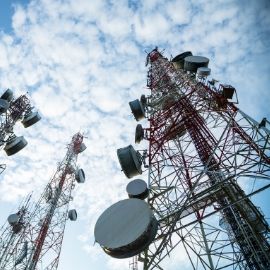Why assess telecommunications infrastructure?
Pager Power’s Telecommunications Impact Assessments typically cover the assessment of microwave links and Ultra-High Frequency (UHF) links, commonly used by mobile phone network operators, utility companies and emergency service stakeholders around the world. Building developments have the potential to adversely affect their operations, most typically as a physical obstruction. Stakeholders operating such infrastructure can object to building developments on these grounds and technical mitigation can be required to address these concerns.
The potential impacts are well understood, and solutions are generally available. In addition, constraints associated with this infrastructure can, in some cases, be accommodated at the design stage if they are identified early in the process.
What are the benefits of a Pager Power Telecommunications Impact Assessment?
A Telecommunications Impact Assessment allows the constraints associated with telecommunications infrastructure in the area around a building development to be clearly defined. Constraints may include the link path itself or a telecommunications mast.
This allows a developer to either avoid these constraints at the design stage or progress mitigation options for potentially affected infrastructure.
What does a Pager Power Telecommunications Impact Assessment Cover?
Consultation
Pager Power will engage with the most relevant telecommunications stakeholders in order to ascertain the technical details required to map the constraints associated with the identified infrastructure. Stakeholders can include those who maintain mobile phone and broadcast services, utility companies, emergency services, and sometimes more local operators.
Surveys
In some cases, it can be beneficial to conduct a field survey of the identified infrastructure, and this most commonly includes visiting the link ends at a mast location. This can facilitate the acquisition of more accurate technical data than can be acquired through consultation alone. It can also identify further constraints that may not have been captured within the consultation process. Surveys are not always required, this will be determined on a case-by-case basis in discussions with the developer.
Exclusion Zones Analysis
Microwave and UHF link paths, as well as the masts the infrastructure is most commonly placed upon, can be effectively protected against impacts from building developments by the modelling of exclusion zones around them. The dimensions of the exclusion zone defined around the identified link paths are frequency-dependent and the stand-off distance required relates specifically to the link length and the proximity of a building development to either link end. It may also be beneficial to consider topography and undertake the modelling in three dimensions to fully understand the extent of any clearance/infringement in 3D space.
Overview of Mitigation
A brief description of the most applicable mitigation solutions is provided in Pager Power’s reports. This provides a basis for agreeing a mitigation strategy with the relevant telecommunications stakeholder, if required.
Recommendations
The next steps recommended to progress the building development and address any potential impacts are defined and presented. We will then discuss with you the results and define a strategy for moving forward.
If you’d like to discuss this service with a member of our team, please get in touch.
How can we help you today?



THE SECTORS WE SERVE













